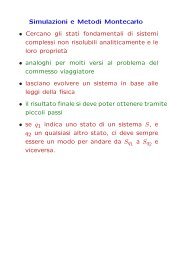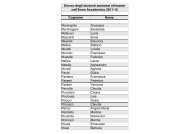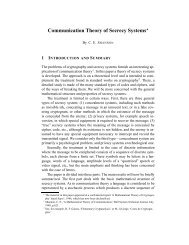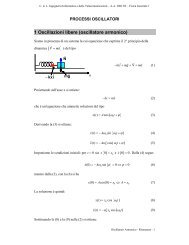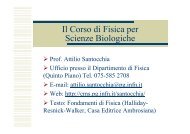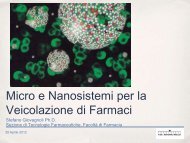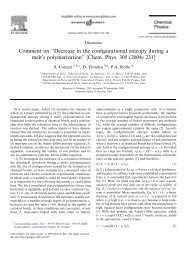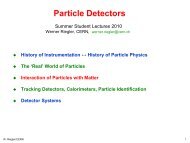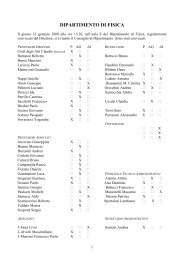Slides - Indico - Cern
Slides - Indico - Cern
Slides - Indico - Cern
Create successful ePaper yourself
Turn your PDF publications into a flip-book with our unique Google optimized e-Paper software.
Particle Detectors<br />
History of Instrumentation ↔ History of Particle Physics<br />
The ‘Real’ World of Particles<br />
Interaction of Particles with Matter, Tracking detectors<br />
Photon Detection, Calorimeters, Particle Identification<br />
Detector Systems<br />
Summer Student Lectures 2007<br />
Werner Riegler, CERN, werner.riegler@cern.ch<br />
W. Riegler/CERN 1
Detectors based on Ionization<br />
Gas Detectors:<br />
• Transport of Electrons and Ions in Gases<br />
• Wire Chambers<br />
• Drift Chambers<br />
• Time Projection Chambers<br />
Solid State Detectors<br />
• Transport of Electrons and Holes in Solids<br />
• Si- Detectors<br />
• Diamond Detectors<br />
W. Riegler/CERN Gas Detectors<br />
2
Gas Detectors with internal Electron Multiplication<br />
• Principle: At sufficiently high electric fields (100kV/cm) the electrons gain<br />
energy in excess of the ionization energy secondary ionzation etc. etc.<br />
• Elektron Multiplication:<br />
– dN = N α dx α…’first Townsend Coefficient’<br />
– N(x) = N 0 exp (αx) α= α(E), N/ N 0 = A (Amplification, Gas Gain)<br />
– N(x)=N 0 exp ( (E)dE )<br />
– In addition the gas atoms are excited emmission of UV photons can ionize<br />
themselves photoelectrons<br />
– NAγ photoeletrons → NA 2 γ electrons → NA 2 γ 2 photoelectrons → NA 3 γ 2 electrons<br />
– For finite gas gain: γ < A -1 , γ … ‘second Townsend coefficient’<br />
W. Riegler/CERN Gas Detectors<br />
3
Wire Chamber: Electron Avalanche<br />
Wire with radius (10-25m) in a tube of radius b (1-3cm):<br />
Electric field close to a thin wire (100-300kV/cm). E.g.<br />
V 0=1000V, a=10m, b=10mm, E(a)=150kV/cm<br />
Electric field is sufficient to accelerate electrons to energies which are<br />
sufficient to produce secondary ionization electron avalanche signal.<br />
b<br />
a<br />
b<br />
Wire<br />
W. Riegler/CERN Gas Detectors<br />
4
From L. Ropelewski<br />
Gas Detectors with internal Electron Multiplication<br />
W. Riegler/CERN 5
Wire Chamber: Electron Avalanches on the Wire<br />
Proportional region: A10 3 -10 4<br />
Semi proportional region: A10 4 -10 5<br />
(space charge effect)<br />
Saturation region: A >10 6<br />
Independent from the number of primary<br />
electrons.<br />
Streamer region: A >10 7<br />
Avalanche along the particle track.<br />
Limited Geiger region:<br />
Avalanche propagated by UV photons.<br />
Geiger region: A10 9<br />
Avalanche along the entire wire.<br />
W. Riegler/CERN Gas Detectors<br />
6
Wire Chamber: Signals from Electron Avalanches<br />
The electron avalanche happens very close to the wire. First multiplication only<br />
around R =2x wire radius. Electrons are moving to the wire surface very quickly<br />
(
Rossi 1930: Coincidence circuit for n tubes Cosmic ray telescope 1934<br />
Geiger Mode<br />
Position resolution is determined<br />
by the size of the tubes.<br />
Signal was directly fed into an<br />
electronic tube.<br />
Detectors with Electron Multiplication<br />
W. Riegler/CERN Gas Detectors<br />
8
Charpak et. al. 1968, Multi Wire Proportional Chamber<br />
Classic geometry (Crossection) :<br />
One plane of thin sense wires is placed<br />
between two parallel plates.<br />
Typical dimensions:<br />
Wire distance 2-5mm, distance between<br />
cathode planes ~10mm.<br />
Electrons (v5cm/s) are being collectes<br />
within in 100ns. The ion tail can be<br />
eliminated by electroniscs filters pulses<br />
100ns typically can be reached.<br />
For 10% occupancy every s one pulse<br />
1MHz/wire rate capabiliy !<br />
W. Riegler/CERN Gas Detectors<br />
9
Charpak et. al. 1968, Multi Wire Proportional Chamber<br />
In order to eliminate the left/right<br />
ambiguities: Shift two wire chambers by<br />
half the wire pitch.<br />
For second coordinate:<br />
Another Chamber at 90 0 relative rotation<br />
Signal propagation to the two ends of<br />
the tube.<br />
Pulse height measurement on both ends<br />
of the wire. Because of resisitvity of the<br />
wire, both ends see different charge.<br />
Segmenting of the cathode into strips or<br />
pads:<br />
The movement of the charges induces a<br />
signal on the wire AND the cathode. By<br />
segmengting and charge interpolation<br />
resolutions of 50m can be achieved.<br />
W. Riegler/CERN Gas Detectors<br />
10
Multi Wire Proportional Chamber<br />
(a)<br />
1.07 mm<br />
0.25 mm<br />
1.63 mm<br />
(b)<br />
Cathode strip:<br />
Width (1) of the charge<br />
distribution DIstance <br />
‘Center of gravity’ defines the<br />
particle trajectory.<br />
C 1 C 1 C 1 C 1 C 1<br />
C 2<br />
Avalanche<br />
C 2<br />
C 2<br />
C 2<br />
Anode wire<br />
Cathode strips<br />
W. Riegler/CERN Gas Detectors<br />
11<br />
C 1
Drift Chambers 1970:<br />
E<br />
In an alternating sequence of wires with different potentials one finds an electric field<br />
between the ‘sense wires’ and ‘field wires’.<br />
The electrons are moving to the sense wires and produce an avalanche which induces a<br />
signal that is read out by electronics.<br />
The time between the passage of the particle and the arrival of the electrons at the wire is<br />
measured.<br />
The drift time T is a measure of the position of the particle !<br />
Amplifier: t=T<br />
Scintillator: t=0<br />
By measuring the drift time, the wire distance can be reduced (compared to the Multi Wire<br />
Proportional Chamber) save electronics channels !<br />
W. Riegler/CERN Gas Detectors<br />
12
Drift Chambers, typical Geometries<br />
W. Klempt, Detection of Particles with Wire Chambers, Bari 04<br />
Electric Field 1kV/cm<br />
W. Riegler/CERN Gas Detectors<br />
13
The Geiger counter reloaded: Drift Tube<br />
ATLAS MDT R(tube) =15mm Calibrated Radius-Time<br />
correlation<br />
ATLAS Muon Chambers<br />
Primary electrons are drifting to<br />
the wire.<br />
Electron avalanche at the wire.<br />
The measured drift time is<br />
converted to a radius by a<br />
(calibrated) radius-time<br />
correlation.<br />
Many of these circles define the<br />
particle track.<br />
ATLAS MDTs, 80m per tube<br />
W. Riegler/CERN Gas Detectors<br />
14
The Geiger counter reloaded: Drift Tube<br />
Atlas Muon Spectrometer, 44m long, from r=5 to11m.<br />
1200 Chambers<br />
6 layers of 3cm tubes per chamber.<br />
Length of the chambers 1-6m !<br />
Position resolution: 80m/tube,
ATLAS Muon Chamber Front-End Electronics<br />
3.18 x 3.72 mm<br />
Harvard University, Boston University<br />
Single Channel Block Diagram<br />
• 0.5m CMOS technology<br />
– 8 channel ASD + Wilkinson<br />
ADC<br />
– fully differential<br />
– 15ns peaking time<br />
– 32mW/channel<br />
– JATAG programmable<br />
Designed around in 1997, produced in 2000, today – 0.17um process … rapidly changing technologies.<br />
W. Riegler/CERN Gas Detectors<br />
16
Large Drift Chambers: Central Tracking Chamber CDF Experiment<br />
660 drift cells tilted 45 0<br />
with respect to the<br />
particle track.<br />
Drift cell<br />
W. Riegler/CERN Gas Detectors<br />
17
y<br />
Time Projection Chamber (TPC):<br />
Gas volume with parallel E and B Field.<br />
B for momentum measurement. Positive effect:<br />
Diffusion is strongly reduced by E//B (up to a<br />
factor 5).<br />
Drift Fields 100-400V/cm. Drift times 10-100 s.<br />
Distance up to 2.5m !<br />
z<br />
x<br />
B drift<br />
E<br />
charged track<br />
gas volume<br />
wire chamber<br />
to detect<br />
projected tracks<br />
W. Riegler/CERN Gas Detectors<br />
18
• Gas Ne/ CO 2 90/10%<br />
• Field 400V/cm<br />
• Gas gain >10 4<br />
• Position resolution = 0.2mm<br />
• Diffusion: t= 250m cm<br />
• Pads inside: 4x7.5mm<br />
• Pads outside: 6x15mm<br />
• B-field: 0.5T<br />
ALICE TPC: Detector Parameters<br />
W. Riegler/CERN Gas Detectors<br />
19
• Largest TPC:<br />
– Length 5m<br />
– diameter 5m<br />
– Volume 88m 3<br />
– Detector area 32m 2<br />
– Channels ~570 000<br />
• High Voltage:<br />
– Cathode -100kV<br />
• Material X 0<br />
– Cylinder from composit<br />
materias from airplane<br />
industry (X 0= ~3%)<br />
ALICE TPC: Konstruktionsparameter<br />
W. Riegler/CERN Gas Detectors<br />
20
Precision in z: 250m<br />
ALICE TPC: Pictures of the construction<br />
Gas Detectors<br />
End plates 250m<br />
Wire chamber: 40m<br />
W. Riegler/CERN 21
ALICE : Simulation of Particle Tracks<br />
• Simulation of particle tracks for a<br />
Pb Pb collision (dN/dy ~8000)<br />
• Angle: Q=60 to 62º<br />
• If all tracks would be shown the<br />
picture would be entirely yellow !<br />
• TPC is currently under<br />
Commissioning !<br />
W. Riegler/CERN Gas Detectors<br />
22
ALICE TPC<br />
My personal<br />
contribution:<br />
A visit inside the TPC.<br />
W. Riegler/CERN Gas Detectors<br />
23
Detectors based on Ionization<br />
Gas detectors:<br />
• Transport of Electrons and Ions in Gases<br />
• Wire Chambers<br />
• Drift Chambers<br />
• Time Projection Chambers<br />
Solid State Detectors<br />
• Transport of Electrons and Holes in Solids<br />
• Si- Detectors<br />
• Diamond Detectors<br />
W. Riegler/CERN Solid State Detectors<br />
24
Solid State Detectors<br />
Originally:<br />
Solid state ionization chambers in Crystals (Diamond, Ge, CdTe …)<br />
Primary ionization from a charged particle traversing the detector moves<br />
in the applied electric field and induced a signal on the metal electrodes.<br />
Principle difficulty:<br />
Extremely good insulators are needed in order to suppress dark currents<br />
and the related fluctuations (noise) which are hiding the signal.<br />
Advantage to gas detectors:<br />
1000x more charge/cm (density of solids 10 3 times density of gas)<br />
Ionization energy is only a few eV (up to times smaller than gas).<br />
W. Riegler/CERN Solid State Detectors<br />
25
Typical thickness – a few 100μm<br />
Diamond Detector<br />
Velocity:<br />
μ e=1800 cm 2 /Vs, μ h=1600 cm 2 /Vs, 13.1eV per e-h pair.<br />
Velocity = μE, 10kV/cm v=180 μm/ns Very fast signals of only a few ns length !<br />
Charges are trapped along their path. Charge collection efficiency approx 50%.<br />
Diamond is an extremely interesting material. The problem is that large size single crystals cannot be grown<br />
at present. The technique of chemical vapor deposition can be used to grow polycrystalline diamonds only.<br />
The boundaries between crystallites are probably responsible for incomplete charge collection in this<br />
material.<br />
W. Riegler/CERN Solid State Detectors<br />
26
Silicon Detector<br />
Velocity:<br />
μ e=1450 cm 2 /Vs, μ h=505 cm 2 /Vs, 3.63eV per e-h pair.<br />
~11000 e/h pairs in 100μm of silicon.<br />
However: Free charge carriers in Si:<br />
T=300 K: n = 1.45 x 10 10 / cm 3 but only 33000e-/h in 300m produced by a<br />
high energy particle.<br />
Why do we use Si as a solid state detector ???<br />
W. Riegler/CERN Solid State Detectors<br />
27
Silicon Detector used as a Diode !<br />
doping<br />
n-type<br />
p-type<br />
p n<br />
W. Riegler/CERN Solid State Detectors<br />
28
Si-Diode used as a Particle Detector !<br />
At the p-n junction the charges are<br />
depleted and a zone free of charge<br />
carriers is established.<br />
By applying a voltage, the depletion<br />
zone can be extended to the entire<br />
diode highly insulating layer.<br />
If an ionizing particle produced free<br />
charge carriers in the diode they<br />
drift in the electric field an produce<br />
an electric field.<br />
As silicon is the most commonly<br />
used material in the electronics<br />
industry, it has one big advantage<br />
with respect to other<br />
materials, namely highly developed<br />
technology.<br />
W. Riegler/CERN Solid State Detectors<br />
29
Fully depleted zone<br />
Silicon Detector<br />
readout capacitances<br />
N (e-h) = 11 000/100μm<br />
Position Resolution down to ~ 5μm !<br />
ca. 50-150 m<br />
SiO 2<br />
passivation<br />
300m<br />
W. Riegler/CERN Solid State Detectors<br />
30
Silicon Detector<br />
Every electrode is connected to an amplifier <br />
Highly integrated readout electronics.<br />
Two dimensional readout is possible.<br />
W. Riegler/CERN Solid State Detectors<br />
31
Picture of an CMS Si-Tracker Module<br />
Outer Barrel module<br />
W. Riegler/CERN Solid State Detectors<br />
32
2,4<br />
m<br />
Inner Barrel & Disks<br />
–TIB & TID -<br />
CMS Tracker Layout<br />
Outer Barrel --<br />
TOB-<br />
End Caps –TEC<br />
1&2-<br />
Total Area : 200m 2<br />
Channels : 9 300 000<br />
W. Riegler/CERN Solid State Detectors<br />
33
CMS Tracker<br />
W. Riegler/CERN 34
Silicon Drift Detector (like gas TPC !)<br />
drift cathodes<br />
ionizing particle<br />
bias HV divider<br />
Collection<br />
pull-up<br />
cathode<br />
W. Riegler/CERN Solid State Detectors<br />
35
Resolution (m)<br />
Silicon Drift Detector (like gas TPC !)<br />
Anode axis (Z)<br />
Drift time axis (R-F)<br />
Drift distance (mm)<br />
W. Riegler/CERN Solid State Detectors<br />
36
Pixel-Detectors<br />
Problem:<br />
2-dimensional readout of strip detectors results in ‘Ghost Tracks’ at<br />
high particle multiplicities i.e. many particles at the same time.<br />
Solution:<br />
Si detectors with 2 dimensional ‘chessboard’ readout. Typical size 50<br />
x 200 μm.<br />
Problem:<br />
Coupling of readout electronics to the detector.<br />
Solution:<br />
Bump bonding.<br />
W. Riegler/CERN Solid State Detectors<br />
37
Bump Bonding of each Pixel Sensor to the Readout Electronics<br />
ATLAS: 1.4x10 8 pixels<br />
W. Riegler/CERN Solid State Detectors<br />
38
Pixel Detector Application: Hybrid Photon Detector<br />
W. Riegler/CERN Solid State Detectors<br />
39
Elektro-Magnetic Interaction of Charged Particles<br />
with Matter<br />
Classical QM<br />
1) Energy Loss by Excitation and Ionization<br />
2) Energy Loss by Bremsstrahlung<br />
3) Cherekov Radiation and 4) Transition Radiation are only minor<br />
contributions to the energy loss, they are however important effects for<br />
particle identification.<br />
W. Riegler/CERN 40
Bremsstrahlung, semi-classical:<br />
A charged particle of mass M and<br />
charge q=Z 1e is deflected by a<br />
nucleus of Charge Ze.<br />
Because of the acceleration the<br />
particle radiated EM waves <br />
energy loss.<br />
Coulomb-Scattering (Rutherford<br />
Scattering) describes the deflection<br />
of the particle.<br />
Maxwell’s Equations describe the<br />
radiated energy for a given<br />
momentum transfer.<br />
dE/dx<br />
W. Riegler/CERN Solid State Detectors<br />
41
Proportional to Z 2 /A of the Material.<br />
Proportional to Z 1 4 of the incoming<br />
particle.<br />
Proportional zu of the particle.<br />
Proportional 1/M 2 of the incoming<br />
particle.<br />
Proportional to the Energy of the<br />
Incoming particle <br />
E(x)=Exp(-x/X 0) – ‘Radiation Length’<br />
X 0 M 2 A/ ( Z 1 4 Z 2 )<br />
X 0: Distance where the Energy E 0 of<br />
the incoming particle decreases<br />
E 0Exp(-1)=0.37E 0 .<br />
W. Riegler/CERN 42
Critical Energy<br />
Elektron Momentum 5 50 500 MeV/c<br />
Critical Energy: If dE/dx (Ionization) = dE/dx (Bremsstrahlung)<br />
Myon in Copper: p 400GeV<br />
Electron in Copper: p 20MeV<br />
For the muon, the second<br />
lightest particle after the<br />
electron, the critical<br />
energy is at 400GeV.<br />
The EM Bremsstrahlung is<br />
therefore only relevant for<br />
electrons at energies of<br />
past and present<br />
detectors.<br />
W. Riegler/CERN 43
W. Riegler/CERN<br />
For E>>m ec 2 =0.5MeV : = 9/7X 0<br />
Average distance a high energy<br />
photon has to travel before it<br />
converts into an e + e - pair is<br />
equal to 9/7 of the distance that a<br />
high energy electron has to<br />
travel before reducing it’s energy<br />
from E 0 to E 0*Exp(-1) by photon<br />
radiation.<br />
44
W. Riegler/CERN<br />
Electro-Magnetic Shower of High Energy Electrons and Photons<br />
45
W. Riegler/CERN 46
W. Riegler/CERN<br />
47
W. Riegler/CERN<br />
48
W. Riegler/CERN<br />
49
W. Riegler/CERN<br />
50
W. Riegler/CERN<br />
51
W. Riegler/CERN<br />
52
W. Riegler/CERN<br />
53
W. Riegler/CERN<br />
54
W. Riegler/CERN<br />
55
W. Riegler/CERN<br />
56



